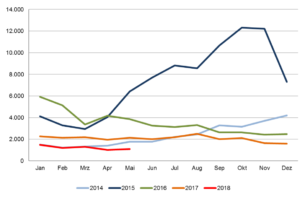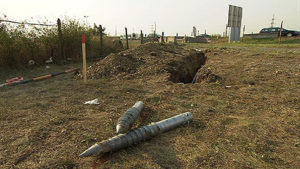By Ivan Josipovic (Austrian Academy of Sciences) and Ursula Reeger (Austrian Academy of Sciences).
Austria has a long tradition as a destination country for migrants and refugees. It is a country that for decades promoted labour migration and admitted refugees during the communist era of Eastern Europe as well as during the Balkan Wars. The notion of the latest advent of mass migration to Austria relates to the increasing number of asylum applications since 2013 and in particular in 2015. In that year alone, application numbers reached a six-decade high of 88,000 persons, while thousands of refugees crossed the country for their onward journey. This latest phase also displays novelties concerning the composition of the newcomers in terms of countries of origin. The three largest groups of asylum applicants in 2015, namely Syrians, Afghans and Iraqis, are relatively new to Austria. In 2017, 102,000 persons born in one of these three countries were registered in Austria, compared to 16,000 in 2011.
Often referred to as a period of crisis, by 2018 Austria has doubtlessly left behind a general state of perceived overextension regarding the issues of refugee reception and integration. While a suggested normalization of course implies the problem of referring to an alleged norm, there are at least three alleviating circumstances that statistically support the argument of increased control over or at least the governability of forced migration and migrant integration.
First, the number of asylum applications is in continuing decline since November 2015, with 6,113 people having lodged an application from January to May 2018. In 2017 already, figures had dropped beneath the pre-crisis level of 2014 (see Figure 1). Border management facilities including fences, tents, and containers at Spielfeld, the major crossing point to Slovenia, are left empty. Early preparations for fencing the frontiers at the crossing point Nickelsdorf towards Hungary have been curbed as well. Screws and fencing material are held at disposition for a possible quick intervention (Picture 1).
Second, the number of asylum applicants in reception facilities has dropped beneath 60,000 persons by mid-2018, a figure that is expected to further decline with sinking asylum applications. In regions like Upper Austria, large-scale facilities are increasingly shut down and most regions attempt to foster individual accommodations. Likewise, the number of open applications at the Federal Office for Immigration and Asylum has halved from around 60,000 cases in March 2016 to 31,500 cases by January 2018.
Third, labour market integration of beneficiaries of asylum and subsidiary protection slightly surpasses early prognosis. The Austrian Labour Market Service reports that of those granted a title in 2015, 26.2 per cent had found an employment by October 2017, of those receiving their title in 2016 around 16.8 per cent had done so. Initial calculations had predicted that it would take five years to integrate half of the newly arrived into the labour market.
However, reducing the political crisis associated with increased migratory movements to mere quantities obscures the deep contradictions underlying contemporary statehood and migration governance in Europe. The balancing of the constitutionally enshrined right to asylum with an unresolved question of EU-wide distribution of refugees, or the reconciliation of integration policies with a highly regulated labour market and a selective welfare state are certainly two permanent struggles to be named. It is needless to say that due to the lack of consistent long term solutions, the topic remains a hotly politicized matter, promising for electoral gains if picked up and framed in accordance with needs and feelings of a certain audience.
Thus, while it remains to be investigated how and to which degree the increasingly restrictive political responses might have affected immigration, it has by now become evident that immigration has vice versa had a strong impact on Austrian politics. The right-wing FPÖ which has traditionally held an issue ownership on this topic as well as the conservatives of ÖVP succeeded at the 2017 parliamentary elections, breaking (once again) the Austrian traditional pattern of grand coalitions. At the level of regions, which have crucial competences regarding the reception of asylum seekers and social aid services, we are witnessing an increasing divergence regarding allowances and different concepts of accommodation. At the EU level, Austria displays an engagement in a disintegration process of a core European polity, namely Schengen, with the repeated renewal of exemption provisions for control and the creation of a border police unit. Given these changing circumstances, it remains to be seen how political dynamics in a multi-level governed migration system will develop in the future and how rationales of a second wave of policies will be translated and dispersed during the Austrian presidency of the Council of the EU in the second half of 2018.


